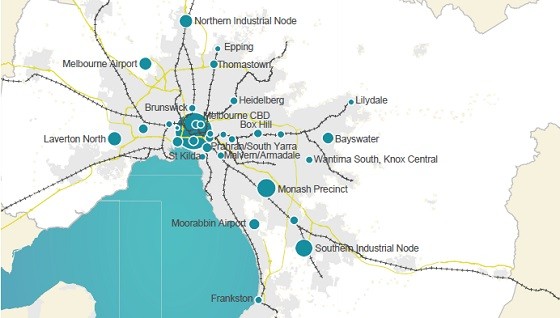
Ted Baillieu’s big idea for the future planning of Melbourne is one he’s apparently borrowed without acknowledgement from his predecessor, former Premier, John Brumby.
Mr Brumby was enthusiastic about the idea of Melbourne as a city of villages where people could “work closer to where they live.” Mr Baillieu’s version is essentially the same – he says Melbourne should be a “20 minute city.”
Speaking at a public forum on the development of the new metropolitan planning strategy for Melbourne on Saturday, he said:
In many parts of the world, cities operate on a 20-minute basis – there’s no reason why we can’t grow that in this city. If you can get a job within 20 minutes, or if you can get to a shopping centre within 20 minutes, then you’ve got a great starting point for a great city.
The notion of the “20 minute city” is set out in more detail in the discussion paper released late last year, Melbourne – let’s talk about the future. It was prepared by the Ministerial Advisory Committee set up by Planning Minister Matthew Guy to advise him on the metropolitan strategy.
The discussion paper indicates the idea includes all transport modes (page 64):
Whether the 20 minute travel distance is by walking, cycling, bus or car will depend on the area and the habits of its residents. Better services and cheaper travel alternatives will provide choice for residents.
At first blush it sounds like mothers milk. Everybody would want to live in a city where everything is really close by.
But nothing comes at nil cost, so to appreciate if this is a worthwhile objective we need to understand what we would have to forego in order to have it.
As I’ve explained before in Should the ’20 minute city’ be the key objective of planning?, there are serious problems with this idea.
For a start, Melbourne already is a 20 minute city, at least in relation to local services. I doubt there’s anywhere in Melbourne, including the outer suburbs, where residents can’t currently get to a shopping centre within 20 minutes by car.
Most suburban trips are already local. For example, 70% of trips by residents of the City of Casey in the outer suburbs are to destinations located in either Casey itself or the adjacent City of Cardinia (the corresponding figure for Cardinia is 83%).
Given around 90% of households in Melbourne have at least one car (and most have two or more, especially in the suburbs), Mr Baillieu’s grand vision doesn’t sound like much of an advance.
However there are some trips that take far longer than 20 minutes. While a lot of jobs are already local, the average one-way journey to work in Melbourne, for example, takes 36 minutes (it’s 30 minutes by car and 55 minutes by public transport).
Journey to work travel times flow from a central fact about cities – they are big places that thrive on diversity and foster specialisation.
Some activities aren’t spread evenly across the metropolitan area but cluster in a limited number of locations.
High-paying jobs that benefit from agglomeration economies concentrate in a few dense locations like the CBD and some larger suburban centres.
There’s also ample evidence that workers have a consistent average travel time “budget”. They will willingly travel further and longer to get to a better job – perhaps it pays more or offers superior conditions.
For example, workers who live in Melbourne’s middle ring suburbs commute one-way on average for 36 minutes and travel on average 12.5 km. Those who live in the outer suburbs commute for much the same time (38 minutes) but travel 19 km.
The few who work in the CBD and can afford a downtown apartment might well get to their high-pay jobs within 20 minutes travelling time door-to-door, but that’s simply not an option for the vast majority of residents in any of Australia’s big cities.
And it’s not only jobs. Many activities benefit from economies of scale and so tend to be centralised at locations of high accessibility.
Trips to destinations like the footy, concerts, universities, and nightclub strips certainly take a lot longer than 20 minutes for the greater than 90% of the population who don’t live in the inner city.
People who live in big cities also don’t confine their friends, lovers and family to those who’re within 20 minutes of home.
Then regard must be given to the differences within households. Even if one member can find a local job he’s happy with, it’s more than likely his partner – and perhaps children too – can’t.
Like Mr Brumby before him, Mr Baillieu has a quaint but out-moded idea that big cities are just a constellation of more or less self-contained little towns.
There are some who take a stronger line on the 20 minute city. They contend that, irrespective of the option of driving, local services should be within 20 minutes travel time by active modes i.e. public transport, cycling and walking.
This too sounds appealing at first glance, especially in relation to cycling. As with cars, I expect the great bulk of dwellings are already within 20 minutes by bicycle of local services.
There’s a problem with perceptions of safety that could largely be addressed by reallocating road space to separated cycling paths, although cycling isn’t an attractive or viable choice for all and it wouldn’t be easy politically.
An obvious problem with the public transport option, though, is once walking and waiting at both trip ends are taken into account, 20 minutes total travel time won’t get you very far.
That could be offset to some extent by denser public transport networks, higher frequencies (e.g. every 10 minutes) and all day operation, but the capital and operating costs in the suburbs would be enormous.
That points to an even more obvious problem. Suburban residents who want to go to the local supermarket, G.P. or hairdresser, will mostly choose to drive because it’s faster and more convenient than even the best public transport system.
And it’s hard to believe residents would accept reverting to the days of a single local whitegoods or hardware store (say) that’s considerably more expensive and has a limited range of goods compared to driving 20 minutes max to a superstore or, increasingly, a cluster of superstores.
Theoretically, we could have local services within 20 minutes walk, cycle or bus ride of every dwelling. But even in the unlikely event residents forsook their cars, either the shopping experience would be appalling by today’s standards or the private and public costs would be ridiculously high.
We’d be better off looking at other more productive ways those funds might be spent.
Financial and political capital is scarce and precious. It needs to be focussed on actions that maximise bang for the buck in terms of economic, social and environmental outcomes.
Although it apparently went down well at Saturday’s public consultation session, the “20 minute city” isn’t serious urban planning – it’s a marketing ploy.
I expect the motivation is misguided rather than cynical, but either way it misunderstands why cities exist and there are far more pressing problems to address with scarce resources.
It’s a silly distraction and doesn’t warrant star billing in the metropolitan strategy discussion paper, much less the blessing of the Premier. It’s bound to be used by interest groups to push their particular agendas.








Crikey is committed to hosting lively discussions. Help us keep the conversation useful, interesting and welcoming. We aim to publish comments quickly in the interest of promoting robust conversation, but we’re a small team and we deploy filters to protect against legal risk. Occasionally your comment may be held up while we review, but we’re working as fast as we can to keep the conversation rolling.
The Crikey comment section is members-only content. Please subscribe to leave a comment.
The Crikey comment section is members-only content. Please login to leave a comment.